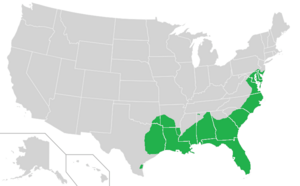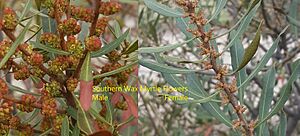Myrica cerifera facts for kids
Quick facts for kids Myrica cerifera |
|
|---|---|
 |
|
| Myrica cerifera near a body of water | |
| Conservation status | |
| Scientific classification | |
| Genus: |
Myrica
|
| Species: |
cerifera
|
 |
|
| Native range in the United States | |
The Myrica cerifera, also known as the southern wax myrtle or southern bayberry, is a small evergreen tree or large shrub. It grows naturally in North and Central America and the Caribbean. People use it in gardens, for making candles, and sometimes as a medicinal plant.
About the Southern Wax Myrtle
The southern wax myrtle is a small tree or a large shrub that can grow up to 14 meters (about 46 feet) tall. It can live in many different places. You can find it in wet areas, near rivers and streams, on sand dunes, in fields, on hillsides, and in different types of forests. This tough plant can handle strong coastal storms, long dry periods, and very hot tropical weather.
Where Does the Wax Myrtle Grow?
This plant grows naturally from Central America all the way north into the southeastern and south-central United States. Gardeners can also grow it successfully in places as far north as New York City and southern Ohio. It also lives in Bermuda and the Caribbean islands. The southern wax myrtle is often one of the first plants to grow in an area after a disturbance, helping new plant life start.
What Does the Wax Myrtle Look Like?
The southern wax myrtle is an evergreen, meaning its leaves stay green all year. Its leaves are long, feel like leather, and have jagged edges. They also have a special smell.
This plant has separate male and female flowers, which grow on different plants. The male flowers have three or four parts that hold pollen. The female flowers turn into small, round fruits that are covered in a natural, waxy coating. The plant flowers from late winter to spring, and its fruits appear in late summer or fall.
The southern wax myrtle can also grow new plants from its underground stems, which are like runners. This means it can spread and create new plants without needing seeds.
Different Forms of the Wax Myrtle
You might see the southern wax myrtle in two main forms, but there are many in-between types. Plants that grow in drier, sandy areas tend to be more like shrubs, with underground stems and smaller leaves. Those that grow in wetter places with richer soil are more like trees and have bigger leaves.
How Wax Myrtle Helps Animals
The fruits of the southern wax myrtle are an important food source for many birds. These include the northern bobwhite quail and the wild turkey. In winter, the seeds are especially important for birds like the Carolina wren and different types of tree sparrows. The plant also provides a safe home for the northern bobwhite quail. Birds help the plant by eating the fruits; their digestive systems remove the wax, which helps the seeds sprout.
Special Roots of the Wax Myrtle
The roots of the southern wax myrtle have special bumps called root nodules. These nodules are home to tiny bacteria that help the plant by taking nitrogen from the air and turning it into a form the plant can use. This process is called nitrogen fixation, and it happens even faster than in plants like beans.
Wax Myrtle and Fire
The parts of the southern wax myrtle that grow above ground, like its leaves and branches, can easily catch fire. This is because they contain special compounds that are flammable. So, a wax myrtle plant can actually be a fire hazard.
However, the plant's root system is very good at surviving fires. Even if the top part of the plant burns, new shoots will often grow back from underground. This regrowth happens fastest in the first year after a fire. But if the plant's top growth is burned repeatedly for several years in a row, it might not survive.
Uses of the Southern Wax Myrtle
Wax Myrtle in the Kitchen
You can use the leaves of the southern wax myrtle in cooking. Just wash and dry them, then add them to stews or sauces for extra flavor. The berries can also be used as a seasoning.
Wax Myrtle in Gardens
The southern wax myrtle is a popular plant for gardening. It's often grown in warmer parts of America. If you live in a colder area, a similar plant called the northern bayberry is often used instead.
This plant is very adaptable, so it can grow in many different conditions. It does need to be trimmed often to keep its shape. Luckily, it can handle even bad trimming! There are at least four special types of wax myrtle that gardeners have developed. Some of these types are smaller or have different shapes, and two of them are even resistant to a plant disease called leaf spot.
Making Candles from Wax Myrtle
The fruits of the southern bayberry have traditionally been used to make Christmas decorations called bayberry candles. To get the wax, people would boil the berries. The wax would float to the top, and they would skim it off. Then, they would boil and strain the wax again. After that, the liquid wax was ready to be used for making candles, either by dipping wicks into it or by pouring it into molds. Other plants related to the southern bayberry can also be used for this purpose.
Today, most "bayberry" candles are not made from real bayberry wax. Instead, they are made from paraffin wax and have artificial colors and scents to make them look and smell like the real thing.
Making Soap from Wax Myrtle
Early settlers in North America also used the wax from boiling the fruit of the Myrica cerifera to make scented bayberry soap.
Images for kids




